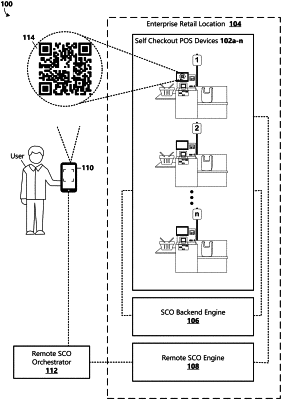| CPC G06Q 20/208 (2013.01) [G06Q 20/108 (2013.01); G06Q 20/3223 (2013.01); G06Q 20/3276 (2013.01); G06Q 30/0633 (2013.01); G06Q 30/0641 (2013.01)] | 21 Claims |

|
1. A system for providing remote self-checkout, comprising:
at least one processor; and
a memory coupled to the at least one processor, the memory including instructions that when executed by the at least one processor cause the system to: receive an indication that a self-checkout session has been initiated at a self-checkout point-of-sale (POS) device;
create a self-checkout cart instance associated with the self-checkout session;
display, on a display of the self-checkout point-of-sale (POS) device, a user interface including a unique coded image associated with the self-checkout session at the self-checkout POS device, the unique coded image comprising information associated with the self-checkout POS device and an instruction for a guest user mobile computing device, wherein the unique coded image, when captured by the guest user mobile computing device, enables the guest user mobile computing device to request a connection with the self-checkout session at the self-checkout POS device according to the instruction;
in response to receiving a first request for the connection, establish a first connection with the guest user mobile computing device and a second connection with the self-checkout POS device based on the information associated with the self-checkout POS device;
receive, from the self-checkout POS device, information associated with a state of the self-checkout cart instance;
provide the information associated with the state of the self-checkout cart instance to the guest user mobile computing device;
receive, from the guest user mobile computing device, information associated with a user interaction in association with the self-checkout session;
provide the information associated with the user interaction to the self-checkout POS device to be processed, wherein processing the information associated with the user interaction causes the state of the self-checkout cart instance to be updated;
update the user interface displayed on the self-checkout POS device based on the updated state of the self-checkout user cart instance;
in response to receiving a second request for a connection with the self-checkout session at the self-checkout POS device and in response to determining that the second request is from an administrative user mobile computing device, establish a third connection with the administrative user mobile computing device based on information comprised in the unique coded image, wherein the unique coded image, when captured by the administrative user mobile computing device, enables the administrative user mobile computing device to request a connection with the self-checkout session at the self-checkout POS device;
provide information associated with the state of the self-checkout cart instance to the administrative user mobile computing device;
receive, from the administrative user mobile computing device, information associated with an administrative user interaction in association with the self-checkout session, wherein the administrative user interaction is an administrative transaction that is not available to be performed at the guest user mobile computing device;
process the information associated with the administrative user interaction, wherein processing the information associated with the administrative user interaction causes the state of the self-checkout cart instance to be updated;
update the user interface displayed on the self-checkout POS device based on the updated state of the self-checkout cart instance;
determine that the self-checkout cart instance is completed; and
terminate the self-checkout session.
|